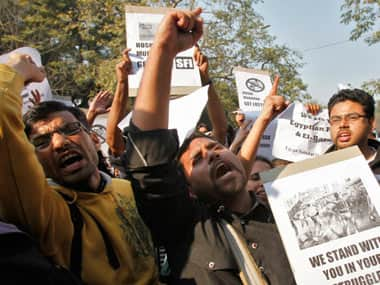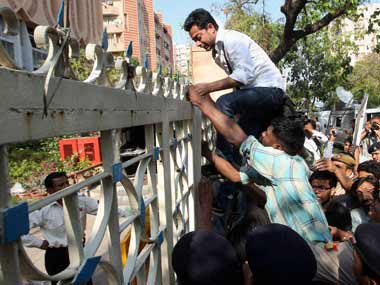“…He was a voracious reader. He used to read books of all kinds well into the night. For him, reading was a means of gaining real education. He dreamt a lot. He used to dream of a new social order, a new dawn,” said the mourning father of Sudipto Gupta, describing his son. Gupta, a 22-year-old post graduate student and leader of CPM’s students’ wing SFI, died of injuries sustained in police custody on Tuesday. The SFI student leader was among hundreds of students who were protesting against the government’s decision to postpone college union elections, and were forced onto a bus by police to take them to jail. While Gupta’s friends say he was battered to death by the police, the police claim he fell out of the bus and hit his head on a lamp post. The intensity of student politics in West Bengal isn’t new. And the violence that accompanies it, isn’t new either. [caption id=“attachment_685782” align=“alignleft” width=“380”]  Student leaders protest outside their college. Reuters[/caption] Since the days of “Amar naam tomaar naam, Vietnam Vietnam (my name, your name Vietnam Vietnam) ” politics have always attracted students in schools and colleges. The academic realm of Bengal has actively been involved in politics and have protested events ranging from Operation Bluestar, the Babri Masjid demolition, and the Godhra riots to the recent Nandigram killings. And violence has often been a part of politics, starting from the Naxalite movement of the 1970s that is now romanticized as the golden age of student politics in Bengal. Campus clashes, being beaten up, beating others, coming back home with a broken nose or bloody forehead has been a part of student life of many leaders of student political bodies like SFI, TMCP (Trinamool Chatro Porishad), CP (Chatro Porishad), ABVP (Akhil Bhartiya Vidyarthi Parishad). So what draws a student to this brand of politics that comes stained with violence? “People since my father’s days have been hearing the same warning when they first stepped out of their houses for college. From Naxals, to Communists, to Trinamools… there hasn’t been one student who hasn’t been warned against politics,” Pratik Shome, a former SFI leader, who was the General Secretary of Scottish Church College in 2007 said. “Students in colleges have always managed themselves to find a guiding torch in their seniors. It might sound strange but at one point of my college life, I have found out that a senior’s sermons were more relevant and important than my own parents’,” he said. “I am sure only a small percentage would know or at least aspire to be a Jyoti Basu among the thousands who were protesting. They went because their friends were going, and it is this sense of friendship and belonging that would always make student politics such a volatile issue,” Shome said. “At that time, we don’t realize its unsafe, or that we are putting our lives at risk. We are simply angry. At everything, “ says Namrata Majumder Dutta, a professional in Bangalore who was a college SFI activist in South City College. [caption id=“attachment_685832” align=“alignright” width=“380”]  Students protest after the death of the SFI leader. PTI[/caption] Earlier, many would join politics in colleges to use it as a stepping stone to national or state politics. Bengal’s history has many examples and among the easily visible ones are former chief minister Buddhadeb Bhattacharjee, who started his career in politics in Presidency College, and current chief minister Mamata Banerjee, who became involved in politics while still in school and became the general secretary of the State Mahila Congress. But, for many, it’s not always ideology or ambition that draws them to student politics. “For me, it’s like an addiction,” says Sudipto Chaterjee, a student of Calcutta University who is a part of the Trinamool Chatro Porishad (TMCP). “As we step into college, we are full of energy and we want change, we want to become popular. Politics is a step towards that,” he said. Sarosij Dasgupta, a lawyer who was with the TMCP during his college days at Jogesh Chandra Choudhury Law College, said, “It starts with gaining popularity, but soon becomes life’s only aim. You cannot think beyond that.” For others its also a stepping stone to a career, but not in politics. “I know people who became a part of the Calcutta University management by participating in SFI politics,” said a senior employee at the University, who was involved in college politics during the 1980s. The greatest motivation, however, remains the desire to bring about change. “The youth are energetic, they are not scared and are ready to conquer. They are not scared to ask questions. For many, the idea of politics is romanticism too. The youth becomes a part of a movement because they think they can bring about change. But, sometimes they end up going the wrong away,” said 65-year-old Subroto Sarkar, who was a part of the Naxal movement. But, following the death of Gupta, will many think before embracing the red, white or green flag in student politics? Unlikely. “Be it the independence movement or the Naxal movement, youth have always played a major role in reshaping our society. And will continue to do so. They were not afraid then, and won’t be afraid in the future," said Sarkar.
What drives students to the student politics of Bengal that comes laced with violence? And will the death of the SFI leader affect sentiment in any way?
Advertisement
End of Article


)
)
)
)
)
)
)
)
)



